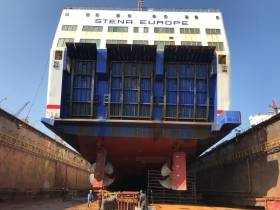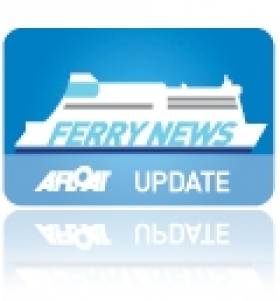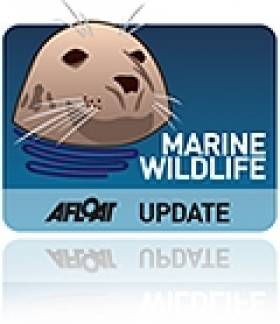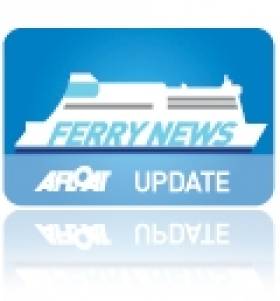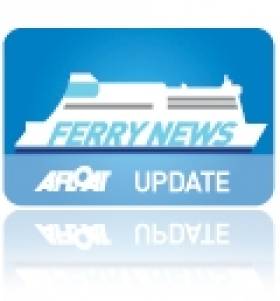Displaying items by tag: Stena Europe
Rosslare-Wales Route Ferry Departs Europe to Undergo Significant Refit Upgrade in Turkey
#ferries - The Rosslare-Fishguard ferry Stena Europe is off service and is currently undergoing a significant three-month refit visit at a shipyard located outside Europe.
Last month Afloat monitored the Ireland-Wales ferry having left familiar waters when off Spain and prior to taking on bunkers in Gibraltar and entering the Meditteranean. According to Stena Line the ferry is at the Gemak Shipyard in Tuzla. The yard is located in the province of Istanbul, Turkey on the Asian side of the city.
The 24,828 gross tonnage ferry which was introduced on the St. Georges Channel route in 2002 is scheduled to return late June 2019 and during the visit a number of upgrade projects will be completed.
One of the most significant projects to be undertaken includes modifications to the deckhead levels on the main vehicle deck to allow for the carriage of full-height trailers across the whole of the main vehicle deck. Prior to arrival at the Turkish shipyard, Stena Europe was restricted to carrying full-height trailers on its port side only.
Other works will include the renewal of the majority of the ship’s windows, engine and hull overhauls including blasting the whole hull to remove all the existing old paint work to improve fuel efficiency and the ships appearance.
Internally, the passenger stairwells will be revamped, a redesign of the Barista Coffee outlet, as well as upgrades to the passenger Information Desk and other decor improvements. During the refit period, the Stena Europe has been replaced by the Stena Nordica on the Rosslare-Fishguard service.
Ian Davies, Stena Line Trade Director (Irish Sea South) said: “Our ongoing ship refit programme is an important part of our business operation ensuring that our fleet operates to its maximum efficiently and is further evidence of Stena Line’s rolling investment programme for the region. The Stena Europe is an important part of our Irish Sea South fleet and we look forward to welcoming a revamped vessel back to our Rosslare-Fishguard service in the summer with the capacity to accommodate even more full-height trailers while still carrying up to 1, 400 passengers.
This is an important year for Stena Line on the Irish Sea as preparations are made to receive the first of its new generation E-Flexer series vessels, the Stena Estrid, which is scheduled to enter service on the Dublin to Holyhead route in early 2020, the first of three new E-Flexer vessels bound for the Irish Sea region..
Stena Line is the largest ferry operator on the Irish Sea, operating routes between Ireland and Britain, including Dublin to Holyhead, Belfast to Liverpool /Heysham and Belfast to Cairnryan. In addition a continental direct service to France between Rosslare and Cherbourg.
Dublin-Bound Ferry Forced to Return to Anglesey
#FerryReturns – A ferry on the Stena Line Holyhead-Dublin Port had to return to Anglesey after reports of a fire on board.
Emergency services were called after smoke was spotted coming from a refrigeration unit on the car deck of the Holyhead to Dublin Stena Europe ferry. No fire was found and the Stena Europe was able to leave for Dublin. For more BBC North Wales reports.
Afloat.ie adds that the Stena Europe has docked in Dublin Port this afternoon having completed the delayed sailing from Wales.
Stena Europe normally operates the Rosslare-Fishguard route and yesterday the ferry made a repositioning voyage to Dublin Port.
The veteran ferry built in 1981 is covering Dublin-Holyhead sailings otherwise operated by Stena Nordica which went off service for dry-docking. The route's second ferry, Stena Adventurer maintains running on schedule.
Stena Europe is due to have an annual refit in Cammell Laird, Birkenhead. Currently there are no sailings between Rosslare-Fishguard until her return on 9 December. An interim replacement service from Rosslare is running instead to Pembroke Dock and this route is operated by Irish Ferries.
Researchers Film Dolphin 'Superpod' In Irish Sea
#MarineWildlife - BBC News has some incredible footage of a 'superpod' comprising hundreds of dolphins in the Irish Sea captured this week.
The video was shot by surprised researchers with the Wales-based Sea Trust on one of the groups routine survey expeditions between Fishguard and Rosslare on board the Stena Europe ferry.
Cliff Benson of the marine wildlife charity described the sea as "boiling" with dolphins just 10 miles off the Irish coast yesterday morning.
"They were just coming and coming. It was the last thing on earth I was expecting in the winter," he said. "We had at least 250 and that's a conservative estimate. I'm guessing there was as many as 500."
The incredible sight comes just a month after the researchers recorded what they called a "dolphin-fest" along the same route west of Tusker Rock, numbering more than a 100 dolphins and 26 porpoises.
BBC News has more on the story HERE - and more footage is available HERE via RTÉ News.
Ferries in Collision at Rosslare Harbour
#FERRY NEWS - A Stena Line ferry was unable to dock in Rosslare last night after a collision with an Irish Ferries passenger craft in heavy winds.
TheJournal.ie reports that the Stena Europe ferry was attempting to dock at Rosslare Harbour after its arrival from Fishguard around 6pm when it made contact with the starboard bow of the Oscar Wilde, which was stationary in port.
RTÉ News says that neither vessel was badly damaged in the incident, but docking was postponed pending the departure of the Irish Ferries vessel, which was expected around 11.30pm last night.
More than 500 passengers and crew were on board the ferry at the time of the incident, which occurred amid gusts of up to 35 knots.
The return journey to Fishguard and this morning's Fishguard-Rosslare sailing were cancelled while an inspection of the vessel gets underway.
Stena Line to Mark History of Wartime Bombed Ferry
#FERRY NEWS - A commemoration plaque in memory to those who lost their lives when the Irish Sea passenger ferry S.S. Patrick (II) was attacked by a bomb from the Luftwaffe during WW2, is to be unveiled in Rosslare Europort next Wednesday.
The tragic attack in 1941 resulted in the 1,922 tonnes vessel sinking with the death of 30 people while the twin-screw steam turbine powered vessel was on passage off the Welsh coast. The ship built in 1930 was launched from the Alexander Stephen & Sons Glasgow (Yard No 525) Glasgow, and she commissioned to serve the St. Georges's channel route between Rosslare and Fishguard.
She had been targeted by a German machine gunner the previous year even though it was not a military vessel and the reasons for its attack have remained a mystery to this day.
Diane Poole OBE, Head of PR and Communications at Stena Line said, "The ship that sank was owned by the Fishguard and Rosslare Railways and Harbours Company (FRRHC), of whom Stena Line along with Irish Rail/Rosslare Europort are descendants.
She added: "Despite the deaths and the trauma attached to the event, the memory of the ship and those who went down with her has largely been lost. There has never been a true commemoration in Ireland of the disaster – until now."
For further information about the tragedy click HERE and a documentary recorded for RTE Radio On can be listened to by clicking this LINK.
The current ferry operating the route is the Stena Europe (1981/24,828grt) which has maintained the route for the last decade. Sailings on the summer schedule will not be boosted by the fast-ferry craft, Stena Lynx III which was sold last year to serve new South Korean owners.
Irish Sea Cross Channel Fast-Ferry Services On Declining Trend
The third service between Belfast-Stranraer is in the hands of rivals Stena Line which maintain the HSS Stena Voyager (1996/19,638 grt) on sailings but only to around mid-November. She will be replaced by conventional sister-ships which will be introduced on the North Channel's newest port when services switch from Stranraer to a new terminal close to Cairnryan.
Finally the fourth fast-ferry is Irish Ferries marketed 'Dublin Swift' service which runs on the Dublin-Holyhead route served by Jonathan Swift (1999/5,989 grt). The craft built by Austal in Fremantle, operates alongside the conventional cruise-ferry Ulysses.
Stena Line's decision to terminate HSS Stena Explorer sailings between Dun Laoghaire-Holyhead this day last week follows fast-ferry Stena Lynx III's end-of-season Rosslare-Fishguard sailings earlier this month.
From next year, Dun Laoghaire-Holyhead sailings are to be seasonal-only and according to Stena Line they hope to resume fast-ferry sailings in April or May though no exact date has been set. Unlike the central corridor route which was entirely dependent on HSS operations, the Rosslare-Fishguard route remains operating year-round with the conventional ferry Stena Europe.
As a result of the discontinued fast-ferries, the HSS Stena Explorer is now spending a lay-up period in the Welsh port for the winter. The smaller Stena Lynx III is also 'wintering' but in on the opposite side of the Irish Sea in Dun Laoghaire, where the vessel has done so in previous years.
The lay-up of both fast-ferries in Dun Laoghaire and Holyhead is ironic considering that neither ports' are connected by the very craft that used to share sailing rosters in recent years. In addition the wintering of these catamaran craft is the first time that this has occurred since the pioneering Stena Sea Lynx fast-ferry launched such sailings in 1993.
This first 'Lynx' provided seasonal sailings on the route with conventional car-ferry Stena Hibernia, the former St. Columba, custom-built in 1977 for Sealink /British Rail. She was given a second name under Stena ownership, the Stena Adventurer and remained on the 57 nautical-mile route until replaced in 1996 by the year-round operated HSS Stena Explorer.
Apart from cross-channel fast-ferry services, the Isle of Man is served by the Isle of Man Steam Packet Co. Ltd's routes linking the islands capital Douglas with Belfast, Dublin, Heysham and Liverpool (Birkenhead) in the winter. These routes include seasonal services which are operated by a combination of conventional tonnage using Ben-My-Chree and fast-ferry Manannan (1998/5,089grt), a former US Navy vessel, to read more click HERE. For sailing schedules, vessel type deployed on route and for fares click HERE.
- Dublin Port
- Irish Ferries
- Dun Laoghaire
- Stena Europe
- Holyhead
- P&O Ferries
- Belfast Harbour
- Stena Line
- Larne
- Ports and Shipping News
- Ulysses
- P&O (Irish Sea)
- Cairnryan
- Ferry news
- Stena Explorer
- Stena Express
- FastFerries
- Cruiseferry
- Manannan
- Isle of Man Steam Packet Co.
- Stena Voyager
- Belast Port
- Isle of Man ferry services
- P&O Express
- Irish Sea fastferries
- Stena 'Lynx'
- BenMyChree
- Dublin Swift
- Stena Sea Lynx
Stena Line to Resume ‘Express’ Service
In addition to the 'Express' service the St. Georges Channel route is served by the year-round operated conventional ferry, Stena Europe (1981/24,828 grt). The 1,386 passenger / 564-vehicle ferry recently underwent a £2m refurbishment and takes a more leisurely passage time of 3 hours 30 minutes.
For information on both fast-ferry and conventional ferry sailing schedules click HERE.
Seasonal Scenes Set for Fishguard
Fast-ferry Stena Lynx III departed Dun Laoghaire for Fishguard Harbour on a repositioning voyage today, writes Jehan Ashmore.
The 80m craft built in Hobart, Tasmania is due to dock at the Pembrokeshire port this afternoon in advance of seasonal sailings on Stena Line's Fishguard-Rosslare.The Stena 'Express' fast-ferry service is to resume in just over a fortnight's time. Sailings are scheduled to a daily single round trip between 1 July-4 September.
The 627 passenger / 120 car capacity fast-ferry will operate in tandem with the year-round operated conventional ferry-service served by the Stena Europe. Passage times are 120 minutes for the fast-ferry service while the Stena Europe takes 3 hours 30 minutes to sail across the St. Georges Channel.
In the same week that the fast-ferry takes up summer sailings from Fishguard, the small French flagged cruiseship Le Diament is to make the first of three calls in July and once in August.
The motoryacht-like vessel which can accommodate 226 passengers is the first cruise caller of the season and is run by the only French-owned cruise operator Compagnie De Iles Du Ponant.
Stena's Southern Sailings
In the meantime freight-only ferry Stena Seafarer is operating the St. Georges Channel route having arrived at Rosslare on a repositioning voyage from Belfast on 29th March.
Stena Seafarer (1975 / 10,957grt) was one of a trio of freight-ferry sisters that served the Larne-Fleetwood port route until its closure in December. Like her sisters Stena Leader (1975 / 12,879grt) and Stena Pioneer (1975 / 14,426grt) they were built at the West German shipyard of J.J. Sietas in Hamburg.
Stena Seafarer's sisters remain laid-up in Belfast and with each vessel over 35 years in service it would seem likely there are nearing the end of their careers, at least on the Irish Sea.
To provide additional passenger capacity the Stena 'Express' fast-ferry service will return to the southern corridor route between 1 July-4 September. The high-season sailings as usual will be operated by the InCat built Stena Lynx III which is to operate a daily single round trip in tandem with Stena Europe.
HSS Fast-Craft to Return on Dun Laoghaire Route
According to Stena Line over 70% of its passengers business is carried by the HSS Stena Explorer in the high season. It is felt that the 1996 Finnish built fast-craft is better suited for the service due to a loyal customer base which was reflected by repeat bookings and their preference of the HSS craft on the 120 minute (2 hour) route.
A daily single round trip is scheduled with sailings from Dun Laoghaire to Holyhead departing at 13:15hrs. The corresponding sailing from the Anglesey port departs at 10.00hrs and arrives at the Irish port at 12 noon. Sailings will operate through the summer until 13 September.
From there on Stena will make a decision as to its continuing schedule, though it is widely believed that the prospects of the fuel-thirsty, expensive to run HSS fast-craft service are likely to be at an end of an era.
Last month negotiations over the core issue of harbour fees were held between Stena Line and Dun Laoghaire Harbour Company. It is understood that the annual fee of €6.5m was dropped to €2m. The board of the harbour company has given a 'conditional green light' of a new ferry contract to Stena Line to run the service for the next two years with an option of a third year.
The service closed for its seasonal break earlier this year on 5 January with the 'Lynx' going into temporary lay-up at Holyhead's inner harbour to join the HSS Stena Explorer. The HSS had been 'wintering' at the port since September sailings were taken over by the Lynx.
Earlier this month the Stena Lynx III came to Dun Laoghaire to continue her lay-up period. The 1996 Tasmanian built craft will stay there before resuming seasonal sailings between Rosslare-Fishguard in tandem with the conventional ferry Stena Europe.
In the meantime the craft is berthed at the harbour's two-berth ferry terminal at St. Michaels Wharf. The HSS berth is only designed for this type of fast-craft whereas the other berth now occupied by the Lynx was built originally for conventional ferries but was re-configured last year to suit the fast-craft.


























